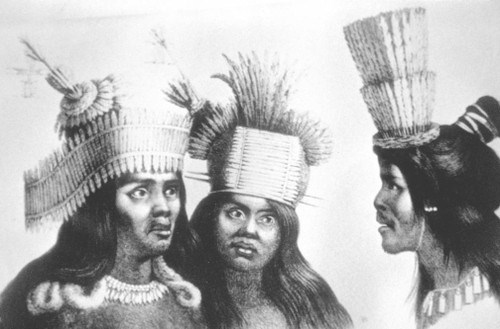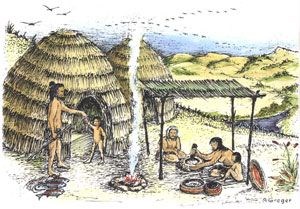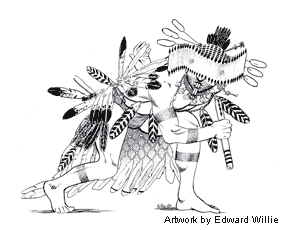Last updated: January 27, 2022
Article
Coast Miwok at Muir Woods

The forests, chaparral, and grasslands of the Marin Peninsula are the traditional homeland of the Coast Miwok people. For more than 10,000 years, Coast Miwok people have lived along the shorelines of Marin County, and continue to live in the county and beyond today. Stewards of the land, they managed the local watershed where creek and ocean resources were most abundant. They hunted, fished and harvested many of the native plants for food, medicine and other traditional uses.
The Redwood Creek watershed is part of the territory of the Huimen group. Their closest year-round community was on the Muir Beach floodplain. The Huimen group managed approximately 38 square miles of land in Marin County. One quarter of the land was dense redwood, including Muir Woods, and more than half was steep terrain.

Although the Coast Miwok may not have lived year-round within Muir Woods, they knew the land well. Their paths probably crossed the forest along ridges and creeks, likely preceding current trail alignments such as the main trail, the Bootjack trail, Fern Creek Trail, and Dipsea Trail. In line with traditional ecological knowledge and relationships to the landscape, they likely used the habitats of Muir Woods as some of the many environments in which they cultivated, pruned, harvested, hunted, and fished. The plants and animals of this area hold special meaning and are important parts of Coast Miwok identity.

Huimen people likely burned areas in/around what’s now Muir Woods every two to three decades. Cultural burns clear out pests, recycle nutrients, spark growth, entice wildlife, and reduce the amount of fuel on the landscape. Further research is required on this landscape management practice as it relates to the various ecosystems within the monument’s boundary: redwood, douglas fir, other forest, grassland, and chaparral.
In the late 1700s, European settlement forced the Coast Miwok off their land and abruptly shifted their way of life forever. In 1783, several members of the Huimen community were the first of the Coast Miwok to leave their homeland for Mission San Francisco. This initial migration was a sign of the times to come. By 1810, introduced diseases, forced labor, and efforts to indoctrinate the indigenous peoples into an alien society and religion led to a tragic destruction of the way of life of Coast Miwoks.
Through learning about the Coast Miwok way of life, we see that appreciating and understanding the unique connections between people and the land is paramount. As the first caretakers of Muir Woods, the Coast Miwok people continue to teach us much. Descendants of the Coast Miwok, members of what is known today as the Federated Indians of Graton Rancheria, continue to participate in research, education, cultural revitalization, and preservation of sacred sites.
For Further Reading:
Chartkoff , Joseph L., and Kerry K. 1984. The Archaeology of California. Stanford University Press, Stanford, California.Colley, Charles C.1970. “The Missionization of the Coast Miwok Indians of California”. California Historical Society Quarterly, 49(2): 143-162.
Cook, Chartkoff, Joseph Sherburne F. 1976. The Conflict Between the California Indian and White Civilization. University of California Press, Berkeley, California.
Heizer, R.F. and M.A. Whipple (contributers and editors). 1971. The California Indians: A Source Book. University of California Press, Berkeley, California.
Kroeber, Alfred L., 1925. Handbook of the Indians of California. Bureau of Ethnology, Bulletin 78, Washington D.C.
Milliken, Randall, 1995. A Time of Little Choice: The Disintegration of Tribal Culture in the San Francisco Bay Area 1769-1810. Ballena Press, Novato, CA.
Moratto, Michael J. 1984. California Archaeology. Academic Press, San Francisco, California.
Peterson, B.J. (editor). 1976. Dawn of the World: Coast Miwok Myths. Marin Museum Society, Impressions Printing, Woodacre, California. Original: Myths and Weird Tales Told by the Mewan Indians of California, Arthur H. Clarke Company, Cleveland, Ohio, 1910.
